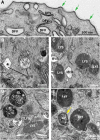Age-related endolysosome dysfunction in the rat urothelium
- PMID: 29883476
- PMCID: PMC5993304
- DOI: 10.1371/journal.pone.0198817
Age-related endolysosome dysfunction in the rat urothelium
Abstract
Lysosomal dysfunction is associated with a number of age-related pathologies that affect all organ systems. While much research has focused on neurodegenerative diseases and aging-induced changes in neurons, much less is known about the impact that aging has on lower urinary tract function. Our studies explored age-dependent changes in the content of endo-lysosomal organelles (i.e., multivesicular bodies, lysosomes, and the product of their fusion, endolysosomes) and age-induced effects on lysosomal degradation in the urothelium, the epithelial tissue that lines the inner surface of the bladder, ureters, and renal pelvis. When examined by transmission electron microscopy, the urothelium from young adult rats (~3 months), mature adult rats (~12 months), and aged rats (~26 months old) demonstrated a progressive age-related accumulation of aberrantly large endolysosomes (up to 7μm in diameter) that contained undigested content, likely indicating impaired degradation. Stereological analysis confirmed that aged endolysosomes occupied approximately 300% more volume than their younger counterparts while no age-related change was observed in multivesicular bodies or lysosomes. Consistent with diminished endolysosomal degradation, we observed that cathepsin B activity was significantly decreased in aged versus young urothelial cell lysates as well as in live cells. Further, the endolysosomal pH of aged urothelium was higher than that of young adult (pH 6.0 vs pH 4.6). Our results indicate that there is a progressive decline in urothelial endolysosomal function during aging. How this contributes to bladder dysfunction in the elderly is discussed.
Conflict of interest statement
The authors have declared that no competing interests exist.
Figures








References
-
- Xu H, Ren D. Lysosomal physiology. Annu Rev Physiol. 2015;77:57–80. Epub 2015/02/11. doi: 10.1146/annurev-physiol-021014-071649 ; PubMed Central PMCID: PMCPMC4524569. - DOI - PMC - PubMed
-
- Bright NA, Davis LJ, Luzio JP. Endolysosomes Are the Principal Intracellular Sites of Acid Hydrolase Activity. Curr Biol. 2016;26(17):2233–45. doi: 10.1016/j.cub.2016.06.046 ; PubMed Central PMCID: PMCPMC5026700. - DOI - PMC - PubMed
-
- Kundu M, Thompson CB. Autophagy: basic principles and relevance to disease. Annu Rev Pathol. 2008;3:427–55. Epub 2007/11/28. doi: 10.1146/annurev.pathmechdis.2.010506.091842 . - DOI - PubMed
-
- Zoncu R, Bar-Peled L, Efeyan A, Wang S, Sancak Y, Sabatini DM. mTORC1 senses lysosomal amino acids through an inside-out mechanism that requires the vacuolar H(+)-ATPase. Science. 2011;334(6056):678–83. Epub 2011/11/05. doi: 10.1126/science.1207056 ; PubMed Central PMCID: PMCPMC3211112. - DOI - PMC - PubMed
-
- Forgac M. Vacuolar ATPases: rotary proton pumps in physiology and pathophysiology. Nat Rev Mol Cell Biol. 2007;8(11):917–29. Epub 2007/10/04. doi: 10.1038/nrm2272 . - DOI - PubMed
Publication types
MeSH terms
Substances
Grants and funding
LinkOut - more resources
Full Text Sources
Other Literature Sources
Medical

